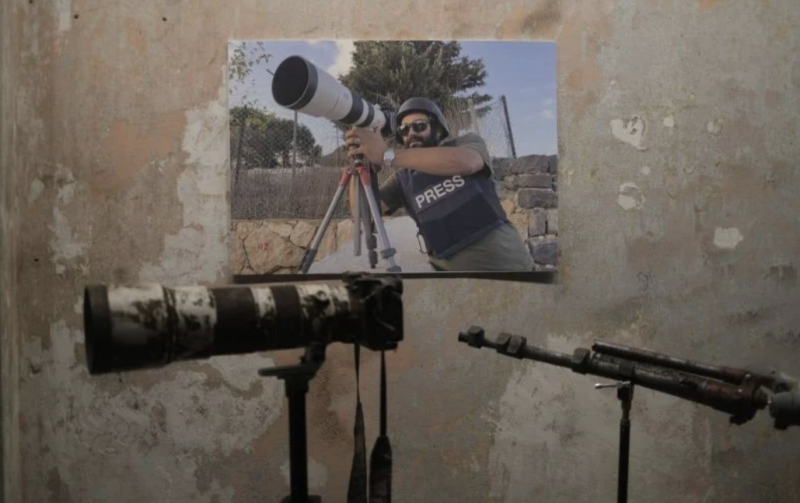
Issam Abdallah's portrait on the premises of As-Safir on Dec. 7, in front of his camera recovered after his death on Oct. 13 in Alma Shaab. (Credit: João Sousa/L'Orient-Le Jour)
Dismay prevailed on Dec.7 in the conference room of As-Safir newspaper in Hamra. Amnesty International and (HRW) invited the press here to present the results of their respective investigations into the Israeli strike that killed Reuters video journalist Issam Abdallah on Oct.13 in Alma al-Shaab, southern Lebanon.
They found that it was a “deliberate” strike, which also injured six journalists from Al Jazeera, AFP and Reuters, who were there covering the renewed tension on the Lebanese-Israeli border, less than a week after the outbreak of the Hamas-Israel war.
AFP and Reuters, which published their findings on the same day, came to the same conclusion.
“I relive that moment every day,” said Dylan Collins, a US journalist forking for AFP who was wounded that day. Invited to speak at the conference as a witness, he confirmed that the group of journalists was “clearly identified as such” before being targeted by two consecutive strikes.
After the first shot, “I saw my colleague Christina Assi on the ground, her legs badly injured, and I used tourniquets to stop the bleeding,” he said.
The body of Issam Abdallah, who was killed instantly, was not discovered until later. He was “barely recognizable.” A second strike 37 seconds later, according to each of the reports, set fire to the Al Jazeera car and injured other journalists, including Dylan Collins.
“I know that these investigations will not bring Issam’s life or Christina’s leg back, but I hope that they will lead to justice,” he said.
‘If there is justice, it will be incomplete’
“It is likely a direct attack on civilians that must be investigated as a war crime,” said Aya Majzoub, Amnesty International’s deputy regional director.
Ramzi Kaiss, a researcher with HRW, also spoke of “an apparently deliberate attack against civilians.”
Unlike Al Jazeera, which directly blamed Israel for the strike, AFP and Reuters investigated for seven weeks to come to this conclusion. It was “in order to gather irrefutable evidence that could lead to legal action,” said Maya Gebeily, Reuters bureau chief for Lebanon, Syria and Jordan, via Zoom.
Reuters, which was initially criticized for not attributing the strike to Israel, is now categorical: “The evidence we now have, and have published today, shows that an Israeli tank crew killed our colleague Issam Abdallah,” said, Reuters’ Editor-in-Chief Alessandra Galloni, quoted in the agency’s investigation.
AFP reached a similar conclusion. At the end of an investigation carried out jointly with the British group of independent experts and investigators Airwars, it concluded, “the munition that killed Abdallah was a 120-mm fin-stabilized tank shell of Israeli origin that is not used by any other groups in the region.”
“The strikes were deliberate and targeted. They arrived within 37 seconds of each other and just a few meters apart,” it added.
While Reuters affirmed that the second strike came from the same tank, according to its analysis of an unpublished video supplied by the Italian broadcaster Rai, the other three investigations were unable to identify the precise nature of the weapon used in the second shot. Contacted by Reuters, Israeli army spokesman Richard Hecht said, “We do not target journalists.”
The four investigations contradict this claim, although it remains for the courts to confirm:
“We said an ‘apparently’ deliberate strike because we are not a court of law,” Kaiss told L’Orient-Le Jour.
Although he noted that “it is not the first time that Israel has targeted journalists in an apparently deliberate manner with impunity,” he said it would be hardly possible to hold Israel accountable before the International Criminal Court (ICC), as neither Lebanon nor Israel are signatories to the ICC.
“But other investigations may be conducted, particularly in the United States, given that Dylan Collins is a US citizen and was also a victim of the strike.”
Al Jazeera journalist Carmen Joukhadar, who was injured on Oct. 13, said, “If ultimately justice is done, it will be incomplete. Because real justice would mean not losing colleagues.”
The Committee to Protect Journalists (CPJ) reported on Dec. 7 thatat least 63 journalists and media workers were killed since the start of the Israel-Hamas war on Oct. 7, including 56 Palestinians, four Israelis and three Lebanese.
This article was originally published by L'Orient-Le Jour. Translated by Joelle El Khoury.